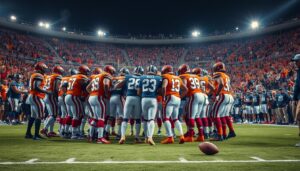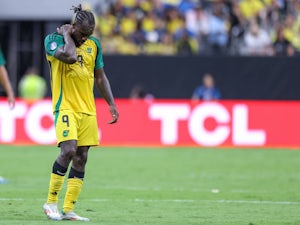The Super Bowl is the annual championship game of the National Football League (NFL). It is one of the most-watched sporting events globally.
The Super Bowl showcases the top teams from the NFL’s American Football Conference (AFC) and National Football Conference (NFC). Held on the first Sunday in February, it features high-profile halftime shows and commercials that captivate millions. The event’s massive viewership makes it a prime opportunity for advertisers and performers.
Super Bowl Sunday has become an unofficial holiday in the United States, bringing together friends and families for parties and celebrations. The game’s cultural impact extends beyond sports, influencing music, fashion, and entertainment. Winning the Super Bowl is the pinnacle of success in American football, with players and coaches striving for this ultimate achievement.

Credit: www.statista.com
History Of Super Bowls
The Super Bowl is the championship game of the National Football League (NFL). It is one of the most-watched sporting events in the world. The history of Super Bowls spans over five decades. It reflects the growth and evolution of American football. This blog post dives into the origins and development of this iconic event.
First Super Bowl
The first Super Bowl took place on January 15, 1967. It was held at the Los Angeles Memorial Coliseum. The Green Bay Packers faced the Kansas City Chiefs. The Packers won with a score of 35-10. This game was originally called the AFL-NFL World Championship Game.
The first Super Bowl was not a sell-out. About 61,000 fans attended, though the stadium could hold 94,000. It was broadcast on two networks, CBS and NBC. The average ticket price was $12. Here is a brief overview:
| Event | Details |
|---|---|
| Date | January 15, 1967 |
| Location | Los Angeles Memorial Coliseum |
| Teams | Green Bay Packers vs. Kansas City Chiefs |
| Result | 35-10, Packers |
| Attendance | 61,946 |
| Ticket Price | $12 |
The game laid the foundation for future Super Bowls. It marked the beginning of a new era in professional football.
Evolution Over The Years
The Super Bowl has evolved dramatically over the years. It has become a major cultural event. The halftime show is now a huge spectacle featuring top artists.
Super Bowl commercials are highly anticipated and often become viral hits. Ticket prices have soared. The average ticket price in recent years is over $5,000.
Here are some key milestones in the evolution of the Super Bowl:
- 1970: The AFL and NFL merged into a single league.
- 1980s: Halftime shows began featuring popular music acts.
- 1993: Michael Jackson performed at halftime, setting a new standard.
- 2004: Introduction of the “Super Bowl Experience” fan event.
- 2010s: Social media amplified the game’s reach and engagement.
Each year, the Super Bowl breaks new records. It attracts millions of viewers worldwide. The event has grown far beyond a simple football game. It is now a global phenomenon.

Credit: en.wikipedia.org
Iconic Moments
The Super Bowl is more than just a game; it’s a spectacle filled with iconic moments that leave fans in awe. Every year, millions of viewers tune in, anticipating not just the winner, but the unforgettable plays and decisions that define the sport. From breathtaking touchdowns to strategic moves, these moments create lasting memories.
Memorable Plays
Memorable plays have defined many Super Bowls, leaving fans with stories to tell for generations. These plays showcase the talent and determination of the players. Here are some of the most unforgettable:
- David Tyree’s Helmet Catch (Super Bowl XLII): In one of the most shocking plays, Tyree caught the ball against his helmet, helping the Giants upset the Patriots.
- Malcolm Butler’s Interception (Super Bowl XLIX): Butler intercepted a pass at the goal line, sealing the win for the Patriots against the Seahawks.
- Santonio Holmes’ Toe-Tap Catch (Super Bowl XLIII): Holmes made a miraculous catch in the end zone, giving the Steelers a last-minute win over the Cardinals.
The following table highlights these memorable plays:
| Player | Play | Super Bowl |
|---|---|---|
| David Tyree | Helmet Catch | XLII |
| Malcolm Butler | Goal Line Interception | XLIX |
| Santonio Holmes | Toe-Tap Catch | XLIII |
These plays are etched in Super Bowl history. They showcase the drama and excitement that make the event so special.
Game-changing Decisions
Game-changing decisions often turn the tide in a Super Bowl, demonstrating the importance of strategy. Coaches and players make split-second choices that can lead to victory or defeat. Some of the most notable decisions include:
- Bill Belichick’s Fourth-Quarter Gamble (Super Bowl XLIX): Belichick chose not to call a timeout, leading to Butler’s game-saving interception.
- Sean Payton’s Onside Kick (Super Bowl XLIV): Payton called for an onside kick to start the second half, shifting momentum to the Saints.
- Doug Pederson’s Philly Special (Super Bowl LII): Pederson’s trick play on fourth down resulted in a touchdown pass to the quarterback, Nick Foles.
These decisions are detailed in the table below:
| Coach | Decision | Super Bowl |
|---|---|---|
| Bill Belichick | Not calling timeout | XLIX |
| Sean Payton | Onside kick | XLIV |
| Doug Pederson | Philly Special | LII |
These choices highlight the strategic depth of football. They show how a single decision can change the course of the game and make history.
Cultural Impact
The Super Bowl is more than just a football game. It is a cultural phenomenon that captures the attention of millions. The event has a profound impact on various aspects of American culture and beyond. From influencing pop culture to driving commercialization, the Super Bowl’s cultural impact is vast and far-reaching.
Influence On Pop Culture
The Super Bowl has a significant influence on pop culture. Every year, it introduces new trends and solidifies cultural moments. The halftime show, for example, has become a stage for iconic performances. Artists like Michael Jackson, Beyoncé, and Shakira have created unforgettable moments.
These performances often go viral, becoming part of the cultural conversation for weeks. They inspire memes, social media trends, and even fashion. The costumes and choreography often set new standards in the entertainment industry.
In addition to music, the Super Bowl impacts television and movies. Many TV shows and movies reference the event, integrating it into their storylines. This keeps the Super Bowl relevant year-round, not just on game day.
- Music: Halftime show performances influence music charts and trends.
- Fashion: Outfits worn during the event set fashion trends.
- Social Media: Memes and trends often originate from Super Bowl moments.
The Super Bowl also introduces new catchphrases and slang. Commercials and commentary often add new words to the cultural lexicon. These phrases become part of everyday conversations, further embedding the Super Bowl into pop culture.
Commercialization
The Super Bowl is a major driver of commercialization. Companies spend millions on advertising during the event. These commercials are often as anticipated as the game itself. Brands use this platform to launch new products and campaigns.
Commercials during the Super Bowl are known for their creativity and humor. They often feature celebrities and elaborate storylines. These ads generate buzz and become talking points for days. Some even become iconic, remembered for years.
Here’s a quick look at the cost of Super Bowl ads over the years:
| Year | Cost of 30-Second Ad |
|---|---|
| 2010 | $2.5 million |
| 2015 | $4.5 million |
| 2020 | $5.6 million |
Beyond ads, the Super Bowl drives sales of merchandise. Fans buy jerseys, hats, and other memorabilia. The event also boosts sales of food and drinks, as Super Bowl parties are a common tradition.
- Advertising: High-budget commercials create memorable moments.
- Merchandise: Sales of team gear and memorabilia skyrocket.
- Food & Drinks: Super Bowl parties drive significant sales.
The Super Bowl’s impact on commercialization is unparalleled. It turns a single game into a multi-billion dollar event, influencing spending habits across the country.
Teams And Rivalries
The Super Bowl is the biggest event in American football. It’s a game where the best teams compete for the championship. Over the years, many teams have created intense rivalries. These rivalries make the games even more exciting for fans. Let’s dive into some legendary matchups and current dominant teams.
Legendary Matchups
Some Super Bowl matchups are unforgettable. These games are famous for their excitement and drama. Here are a few legendary matchups:
- Super Bowl III: The New York Jets vs. the Baltimore Colts. The Jets’ win was a huge upset.
- Super Bowl XXV: The New York Giants vs. the Buffalo Bills. The game ended with a missed field goal.
- Super Bowl XXXIV: The St. Louis Rams vs. the Tennessee Titans. The game ended with a tackle at the 1-yard line.
These games are remembered for their close scores and dramatic endings. They are proof of how thrilling the Super Bowl can be.
| Super Bowl | Teams | Notable Moment |
|---|---|---|
| III | New York Jets vs. Baltimore Colts | Jets’ upset win |
| XXV | New York Giants vs. Buffalo Bills | Missed field goal |
| XXXIV | St. Louis Rams vs. Tennessee Titans | Tackle at the 1-yard line |
Current Dominant Teams
In recent years, some teams have dominated the Super Bowl. These teams often make it to the playoffs and have strong rosters. Here are a few current dominant teams:
- New England Patriots: Led by Tom Brady, they won multiple Super Bowls in the 2000s and 2010s.
- Kansas City Chiefs: With Patrick Mahomes, they have been strong contenders in recent years.
- San Francisco 49ers: Known for their strong defense and smart coaching.
These teams have set high standards in the NFL. They are known for their skill, strategy, and strong performances.
| Team | Key Player | Strength |
|---|---|---|
| New England Patriots | Tom Brady | Experience and strategy |
| Kansas City Chiefs | Patrick Mahomes | Offensive power |
| San Francisco 49ers | Strong Defense | Defensive tactics |
Fans look forward to seeing these teams in action. They bring excitement and high-level play to the Super Bowl.
Halftime Shows
The Super Bowl is not just about football. It’s also about the legendary halftime shows. Each year, millions of people tune in to watch the most iconic performers take the stage. These shows often steal the spotlight and become a talking point for weeks. Let’s dive into the world of Super Bowl Halftime Shows.
Famous Performances
Over the years, many performances have become unforgettable. Michael Jackson’s 1993 performance set the standard. He dazzled the audience with his moonwalk and hits like “Billie Jean” and “Black or White”.
Prince’s 2007 show is another standout. He performed in the rain, making “Purple Rain” even more magical. The rain seemed choreographed with his music.
Beyoncé’s 2013 performance was electrifying. She reunited with Destiny’s Child and wowed the crowd with “Single Ladies” and “Crazy in Love”.
Other notable performances include:
- Madonna (2012) – Her show featured guest appearances from LMFAO, Nicki Minaj, and M.I.A.
- Lady Gaga (2017) – She stunned with acrobatics and a medley of her greatest hits.
- Shakira and Jennifer Lopez (2020) – Their performance highlighted Latin culture and was full of energy.
These performances are more than just music. They are cultural moments that people remember for years.
Impact On Music Industry
Super Bowl Halftime Shows have a huge impact on the music industry. Artists see a spike in sales and streaming after performing. For example, Lady Gaga’s album sales jumped 1000% after her 2017 performance.
These shows also offer a platform for new music. Artists often debut new songs, which become instant hits. The exposure is priceless, reaching millions of viewers worldwide.
Performers often collaborate with other artists, leading to new projects and partnerships. Beyoncé’s reunion with Destiny’s Child reignited interest in their music.
Here’s a table showing the impact on album sales for some artists:
| Artist | Year | Album Sales Increase |
|---|---|---|
| Lady Gaga | 2017 | 1000% |
| Bruno Mars | 2014 | 164% |
| The Weeknd | 2021 | 385% |
The Super Bowl Halftime Show is more than entertainment. It’s a launchpad for music careers. It changes the trajectory of artists’ careers and influences music trends.

Credit: www.reddit.com
Super Bowl Parties
The Super Bowl is one of the biggest sports events in the United States. Millions gather to watch the game, enjoy commercials, and celebrate with friends and family. Super Bowl parties have become a significant part of the experience, bringing people together for food, fun, and football.
Party Trends
Super Bowl parties have evolved over the years. Trendy decorations and themes are essential to creating a festive atmosphere. Here are some popular trends:
- Team Colors: Decorate with the colors of the competing teams.
- Photo Booths: Set up a photo booth with football-themed props.
- Big Screens: Rent or buy large screens for a better viewing experience.
- Interactive Games: Include games like football trivia or a mini football toss.
Hosting a successful Super Bowl party involves more than just watching the game. Creating an engaging environment is key. Many hosts now use DIY crafts for decorations. This adds a personal touch and makes the event feel unique. Technology also plays a big role. Apps and streaming services allow for better viewing and interaction. Consider setting up a social media wall to display guests’ posts and photos live during the event.
Food And Drinks
Food and drinks are the heart of any Super Bowl party. Classic dishes like wings and nachos are always a hit. Here are some popular options:
| Food | Drinks |
|---|---|
| Buffalo Wings | Beer |
| Nachos | Soda |
| Pizza | Cocktails |
| Sliders | Mocktails |
Finger foods are popular because they are easy to eat while watching the game. Healthy options are also becoming trendy, such as veggie trays and fruit platters. Drinks should cater to all guests. Offer a variety of alcoholic and non-alcoholic options to keep everyone happy. Signature cocktails themed around the teams playing can add a fun twist to the drink menu. Consider setting up a DIY drink station where guests can mix their own drinks. This interactive element can make the party more enjoyable.
Economic Effects
The Super Bowl is more than just a football game. Its effects on the economy are massive and far-reaching. From local businesses to advertising giants, everyone feels the impact. Let’s explore the economic effects of the Super Bowl.
Local Economy Boost
The Super Bowl gives a significant boost to the local economy of the host city. Hotels fill up with guests from all over the country. Restaurants and bars see a surge in patrons, eager to enjoy the big game atmosphere. The influx of visitors brings more money into the city.
Here are some of the key economic benefits:
- Increased tourism: Visitors spend money on accommodation, food, and entertainment.
- Job creation: Temporary jobs are created in sectors like hospitality, security, and transportation.
- Retail sales: Stores see increased sales of team merchandise and other goods.
The table below shows the estimated spending by visitors during the Super Bowl:
| Category | Estimated Spending |
|---|---|
| Accommodation | $150 million |
| Food and Beverage | $100 million |
| Retail | $50 million |
| Transportation | $30 million |
These figures highlight the massive economic boost the Super Bowl provides to the local economy.
Advertising Revenue
The Super Bowl is famous for its commercials. Companies spend millions on these ads because they reach a huge audience. In 2023, the cost of a 30-second ad was over $7 million.
Here are some key points about Super Bowl advertising revenue:
- High viewership: Over 100 million people watch the Super Bowl each year.
- Brand exposure: Ads during the game give brands massive exposure.
- ROI: Many companies see a high return on investment from their Super Bowl ads.
The table below shows the cost of a 30-second ad over the years:
| Year | Cost |
|---|---|
| 2015 | $4.5 million |
| 2018 | $5 million |
| 2021 | $5.5 million |
| 2023 | $7 million |
These costs show how valuable Super Bowl ads are to companies. The high costs are worth it for the exposure and brand recognition they get.
Future Of Super Bowls
The Super Bowl has always been more than just a football game. It’s a cultural event that brings people together. But what does the future hold for this iconic event? The future of Super Bowls is set to be even more exciting with technological innovations and changing audience engagement leading the way.
Technological Innovations
Technological advancements are redefining the Super Bowl experience. Fans can expect more immersive and interactive ways to enjoy the game. Here are some key innovations:
- Virtual Reality (VR): VR can provide a stadium-like experience from the comfort of your home. Imagine watching the game as if you are on the field.
- Augmented Reality (AR): AR can enhance real-time stats and player information. This can be displayed on your screen while you watch the game.
- 5G Connectivity: Faster internet speeds can make streaming smoother. Fans can enjoy high-definition video without any lag.
Technological innovations are not limited to fans at home. Stadiums are also getting smarter. Here’s a table showing some future enhancements:
| Innovation | Description |
|---|---|
| Smart Seats | Seats equipped with screens for instant replays and live stats. |
| Cashless Transactions | Use mobile payments for food, drinks, and merchandise. |
| Drone Shows | Drone shows during halftime can offer a spectacular visual treat. |
Changing Audience Engagement
Audience engagement is evolving. Fans are no longer passive viewers. They want to be part of the action. Social media platforms play a huge role in this shift. Here are some ways in which audience engagement is changing:
- Real-Time Interaction: Fans can tweet, post, and comment in real-time. This makes them feel more connected to the event.
- Live Polls and Quizzes: These can be integrated into the broadcast. Fans can vote on game predictions and answer trivia questions.
- Fan-Created Content: Platforms like TikTok and Instagram allow fans to create and share their own Super Bowl content.
Brands are also changing how they engage with audiences. Traditional commercials are being complemented with interactive ads. Here are a few examples:
| Brand | Engagement Strategy |
|---|---|
| Pepsi | Interactive ads that let fans choose the storyline. |
| Budweiser | Social media challenges that encourage fan participation. |
| Amazon | Live Q&A sessions with celebrities during halftime. |
The future of the Super Bowl is bright. It’s set to be more interactive, engaging, and technologically advanced.
Frequently Asked Questions
What Is The Super Bowl?
The Super Bowl is the annual championship game of the NFL. It’s the most-watched sporting event in the United States. It features the best teams from the AFC and NFC.
When Is The Super Bowl Played?
The Super Bowl is typically played on the first Sunday in February. It marks the end of the NFL season. This event is highly anticipated by fans.
How Are Super Bowl Teams Determined?
Super Bowl teams are the champions of the AFC and NFC. They win their respective conference championships. These teams have proven themselves throughout the season.
Why Is The Super Bowl So Popular?
The Super Bowl is popular due to its exciting gameplay and halftime show. It also features high-profile commercials. The combination of sports and entertainment draws a massive audience.
Conclusion
Super Bowls bring excitement, tradition, and unity to fans across the globe. From thrilling games to memorable halftime shows, the event never disappoints. It’s a celebration of athletic excellence and entertainment. Dive into the world of Super Bowls, and experience the magic each year brings.
Don’t miss out on the action!




